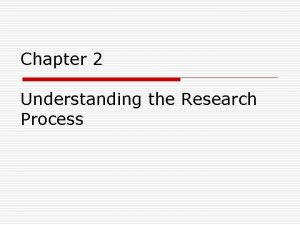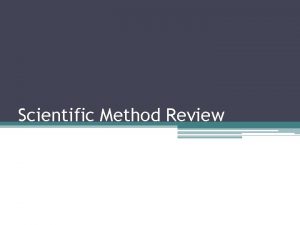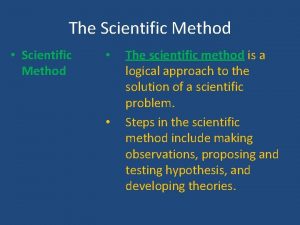CONDUCTING PSYCHOLOGICAL RESEARCH STEPS OF SCIENTIFIC METHOD RESEARCH

















- Slides: 17

CONDUCTING PSYCHOLOGICAL RESEARCH

STEPS OF SCIENTIFIC METHOD

RESEARCH Research —systematic inquiry aimed at the discovery of new knowledge—is a central ingredient of the scientific method in psychology. It provides the key to understanding the degree to which hypotheses (and theories behind them) are accurate. Just as we can apply different theories and hypotheses to explain the same phenomena, we can use a number of alternative methods to conduct research.

METHODS IN PSYCHOLOGY A wide range of research methods are used in psychology. These methods vary by the sources of information that are drawn on, how that information is sampled, and the types of instruments that are used in data collection.

Methods Qualitative research-- aim to gather an in-depth understanding of human behavior and the reasons that govern such behavior. The qualitative method investigates the why and how of decision making, not just what, where, when. Hence, smaller but focused samples are more often used than large samples. Quantitative research-- refers to the systematic empirical investigation of social phenomena via statistical, mathematical or numerical data or computational techniques. The objective of quantitative research is to develop and employ mathematical models, theories and/or hypotheses pertaining to phenomena

TYPES OF PSYCHOLOGICAL RESEARCH There are three main types of psychological research: Descriptive 1. Descriptive research 2. Correlational research Psychological Research 3. Experimental research Experimental Correlational

Descriptive Research Let’s begin by considering several types of descriptive research designed to systematically investigate a person, group, or patterns of behavior.

Descriptive Research Archival Research Naturalistic Observation Survey Research Case Study

Archival Research Def: Research in which existing data, such as census documents, college records, and newspaper clippings, are examined to test a hypothesis. For example, college records may be used to determine if there are gender differences in academic performance (Sullivan, Riccio, & Reynolds, 2008).

Characteristics: Strength: Archival research is a relatively inexpensive means of testing a hypothesis because someone else has already collected the basic data. Drawbacks: For one thing, the data may not be in a form that allows the researcher to test a hypothesis fully. The information could be incomplete, or it could have been collected haphazardly (Riniolo et al. , 2003; Simonton, 2000 a; Vega, 2006). Most attempts at archival research are hampered by the simple fact that records with the necessary information often do not exist. In these instances, researchers often turn to another research method.

Naturalistic Observation DEF: In naturalistic observation, the investigator observes some naturally occurring behavior and does not make a change in the situation. For example, a researcher investigating helping behavior might observe the kind of help given to victims in a high-crime area of a city. The important point to remember about naturalistic observation is that the researcher simply records what occurs, making no modification in the situation that is being observed (Moore, 2002; Rustin, 2006; Schutt, 2001).

Characteristics: Advantage: we get a sample of what people do in their “natural habitat”. Drawbacks: 1. The inability to control any of the factors of interest. For example, we might find so few naturally occurring instances of helping behavior that we would be unable to draw any conclusions. 2. Because naturalistic observation prevents researchers from making changes in a situation, they must wait until the appropriate conditions occur. 3. Furthermore, if people know they are being watched, they may alter their reactions and produce behavior that is not truly representative.

Survey Research In survey research, a sample of people chosen to represent a larger group of interest (a population) is asked a series of questions about their behavior, thoughts, or attitudes. Example: Researchers investigating helping behavior might conduct a survey by asking people to complete a questionnaire in which they indicate their reluctance for giving aid to someone.

Sampling sampling is concerned with the selection of a subset of individuals from within a population to estimate characteristics of the whole population.

Drawbacks If the sample of people who are surveyed is not representative of the broader population of interest, the results of the survey will have little meaning. Consequently, researchers using surveys strive to obtain a random sample of the population in question, in which every voter in the town has an equal chance of being included in the sample receiving the survey. Survey respondents may not want to admit to holding socially undesirable attitudes. (Most racists know they are racists and might not want to admit it. ) People may not even be consciously aware of what their true attitudes are or why they hold them.

Case Study A case study is an in-depth, intensive investigation of a single individual or a small group. For example: Sigmund Freud developed his theories through case studies of individual patients. Similarly, case studies of terrorists might help identify others who are prone to violence.

Drawback: If the individuals examined are unique in certain ways, it is impossible to make valid generalizations to a larger population. Still, they sometimes lead the way to new theories and treatments for psychological disorders.
 Steps in psychological research
Steps in psychological research Conducting research steps
Conducting research steps Information gathered during an experiment
Information gathered during an experiment 7 steps of the scientific method
7 steps of the scientific method 7 steps of the scientific method
7 steps of the scientific method What are the 7 steps of the scientific method
What are the 7 steps of the scientific method 6 steps of scientific inquiry
6 steps of scientific inquiry What are the 5 steps in the scientific method
What are the 5 steps in the scientific method Important of scientific method
Important of scientific method Scientific method steps
Scientific method steps Scientific method 5 steps
Scientific method 5 steps 7 steps of the scientific method
7 steps of the scientific method 7 steps of the scientific method
7 steps of the scientific method Steps of scientific method
Steps of scientific method What are the six steps of the scientific method
What are the six steps of the scientific method 9 steps in scientific method
9 steps in scientific method Scientific method steps
Scientific method steps Scientific method steps
Scientific method steps

































